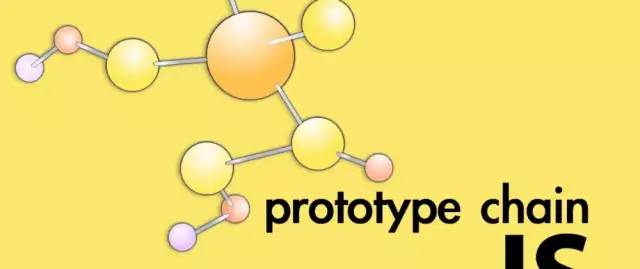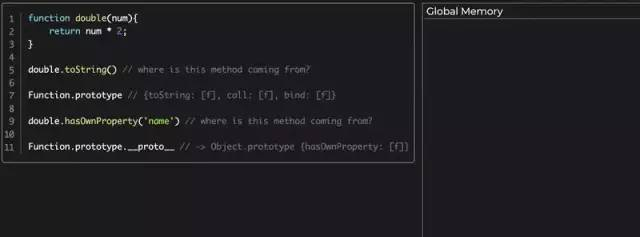
了解原型链继承的概念
这篇文章,我们来学习一下 JavaScript 原型链。我们将了解对象之间是怎么关联的,以及如何实现对象之间的继承关系。
1目标
作为开发人员,我们写代码的主要任务就是操作数据。我们获取数据并将其存储在某些位置,然后在数据上执行一些功能。
如果能将功能和相关数据绑在一块,那岂不是更好?这样对我们来说操作起来更容易。
假设有一个 Player 对象:
{
userName: 'sag1v',
score: '700'
}
如果想要在这个对象上执行一些功能,比如修改分数,该怎么做呢?我们要把setScore方法放在哪呢?
2对象
当我们想保存相关数据的时候,经常会用到对象。对象就像一个箱子,可以往里面放各种相关的东西。
在深入了解之前,我们先要搞清楚 Object 到底是什么,以及创建对象的一些方式。
对象字面量
const player1 = {
userName: 'sag1v',
score: '700',
setScore(newScore){
player1.score = newScore;
}
}
对象字面量表示法(或者叫“对象初始化器”)是一个表达式,每当表达式所在的语句执行时都会创建一个新对象。
我们也可以用点号和方括号来创建和访问对象的属性:
const player1 = {
name: 'Sagiv',
}
player1.userName = 'sag1v';
player1['score'] = 700;
player1.setScore = function(newScore) {
player1.score = newScore;
}
Object.create
另外一种创建 Object的方式是使用 Object.create 方法:
const player1 = Object.create(null)
player1.userName = 'sag1v';
player1['score'] = 700;
player1.setScore = function(newScore) {
player1.score = newScore;
}
Object.create 总是返回一个新的空对象,但如果我们传给它另一个对象,就会得到额外的功能。我们稍后会再讲。
自动化
显然,我们不想每次都手动创建这些对象,我们可能想让这个操作自动化。因此,让我们写一个函数来为我们创建Player对象。
工厂方法
function createPlayer(userName, score) {
const newPlayer = {
userName,
score,
setScore(newScore) {
newPlayer.score = newScore;
}
}
return newPlayer;
}
const player1 = createPlayer('sag1v', 700);
这种模式通常称为“工厂方法”,有点像工厂中的传送带输出货物,我们传入相关参数并返回我们需要的Object 。
如果我们运行这个函数两次会发生什么?
function createPlayer(userName, score) {
const newPlayer = {
userName,
score,
setScore(newScore) {
newPlayer.score = newScore;
}
}
return newPlayer;
}
const player1 = createPlayer('sag1v', 700);
const player2 = createPlayer('sarah', 900);
我们会得到两个这样的对象:
{
userName: 'sag1v',
score: 700,
setScore: ?
}
{
userName: 'sarah',
score: 900,
setScore: ?
}
你注意到重复的地方了吗?
每个实例都存了一份setScore ,这就违反了D.R.Y原则(Don't Repeat Yourself,不要重复自己) 。
能不能在其他某个地方只存一份,但仍然能够通过对象实例访问:player1.setScore(1000)?
OLOO - 链式对象(Objects Linked To Other Objects)
让我们回到 Object.create,我们说过它总是生成一个空对象,但如果给它传一个对象,我们会得到额外的功能。
const playerFunctions = {
setScore(newScore) {
this.score = newScore;
}
}
function createPlayer(userName, score) {
const newPlayer = Object.create(playerFunctions);
newPlayer.userName = userName;
newPlayer.score = score;
return newPlayer;
}
const player1 = createPlayer('sag1v', 700);
const player2 = createPlayer('sarah', 900);
这段代码跟前面的代码很像,只有一个重要的差别,就是新的实例不再直接定义setScore ,而是链接到playerFunctions里的方法。
原来,JavaScript 里的所有对象都有一个特殊的隐藏属性 __proto__ ,如果这个属性指向某个对象,JS 引擎就认为原对象也有这个对象上的属性。换句话说,每个对象可以通过__proto__属性链接到其他对象,并能访问上面的属性,就好像是自有的一样。
注意:不要混淆了
__proto__和prototype,只有函数才有prototype属性,而__proto__只存在于对象上。不过让人迷惑的是,__proto__属性在EcmaScript 规范里叫做[[Prototype]],迷不迷?
我们稍后再讲这个。????
还是来看一个代码示例吧:
const playerFunctions = {
setScore(newScore) {
this.score = newScore;
}
}
function createPlayer(userName, score) {
const newPlayer = Object.create(playerFunctions);
newPlayer.userName = userName;
newPlayer.score = score;
return newPlayer;
}
const player1 = createPlayer('sag1v', 700);
const player2 = createPlayer('sarah', 900);
console.log(player1)
console.log(player2)
输出:
player1: {
userName: 'sag1v',
score: 700,
__proto__: playerFunctions
}
player2: {
userName: 'sarah',
score: 900,
__proto__: playerFunctions
}
看到没,player1 和 player2都能访问playerFunctions的属性,所以都能调用setScore:
player1.setScore(1000);
player2.setScore(2000);
目的达到了,我们将数据和功能附加到对象上,同时也没有违背D.R.Y 原则。
但是仅仅为了创建互连对象,这么做似乎太费劲了。
需要创建对象
创建另一个对象用来存放功能函数
用
Object.create将__proto__链接到那个功能函数对象设置新对象的各种属性
返回这个新对象
这些工作能不能替我们自动完成?
new 操作符,也就是构造函数
在前面的例子中我们看到,为了创建互连对象,我们在工厂方法里做了不少工作。其实 JavaScript 可以为我们完成一部分工作,只要在函数调用前用一个new 操作符。
不过在此之前,先确保我们对函数的理解是一致的。
函数到底是什么?
function double(num) {
return num * 2;
}
double.someProp = 'Hi there!';
double(5); // 10
double.someProp // Hi there!
double.prototype // {}
我们都知道函数是什么,对吧?我们可以声明它,然后用圆括号 ()调用它。但是看看上面的代码,我们也可以在上面读取或创建属性,就像处理对象一样。所以我的结论是 JavaScript 中的函数不仅仅是函数,它们是“函数-对象混合体”。基本上每个函数都可以被调用,并且可以被当作对象来对待。
prototype 属性
原来,所有函数(箭头函数除外)都有一个.prototype属性。
再次提醒:
不是
__proto__或者[[Prototype]], 而是prototype.
让我们再回到 new 操作符。
执行 new 操作符
可用 new 操作符的函数大概长这样:
如果你不太确定 this关键字的工作原理,可以看看这篇文章 JavaScript - The "this" key word in depth
function Player(userName, score){
this.userName = userName;
this.score = score;
}
Player.prototype.setScore = function(newScore){
this.score = newScore;
}
const player1 = new Player('sag1v', 700);
const player2 = new Player('sarah', 900);
console.log(player1)
console.log(player2)
输出结果:
Player {
userName: "sag1v",
score: 700,
__proto__: Player.prototype
}
Player {
userName: "sarah",
score: 900,
__proto__: Player.prototype
}
拆解代码(执行阶段)
我们使用new 操作符执行 Player函数,请注意,我将函数名从 createPlayer 改为Player,只是因为这是命名惯例。这是告诉Player函数的使用者,这是一个“构造函数”,应该用new操作符调用。
当我们使用new操作符调用函数时,JavaScript 为我们做了4件事:
创建一个新对象
把新对象赋值给
this上下文把新对象的
__proto__指向构造函数的prototype属性,在这里是Player.prototype。返回这个新对象,除非你返回一个不同的对象
如果我们把 JavaScript 自动完成的步骤写下来,大概是这样的:
function Player(userName, score){
this = {
} // ? done by JavaScript
this.__proto__ = Player.prototype // ? done by JavaScript
this.userName = userName;
this.score = score;
return this // ? done by JavaScript
}
来看第3步:
把新对象的
__proto__指向构造函数的prototype属性,在这里是Player.prototype
就是说我们可以在Player.prototype上设置任何方法,新创建的对象都自动拥有这些方法了。
我们就是这样做的:
Player.prototype.setScore = function(newScore){
this.score = newScore;
}
这就是如何通过构造函数创建链式对象的。
顺便说一下,如果我们不使用new操作符,JavaScript 就不会为我们完成这些任务,我们最终只会在 this上下文中修改或创建一些属性。记住这一点,我们将在执行子类化时使用这个技巧。
有办法可以确保函数是通过 new 操作符调用的:
function Player(username, score){
if(!(this instanceof Player)){
throw new Error('Player must be called with new')
}
// ES2015 syntax
if(!new.target){
throw new Error('Player must be called with new')
}
}
类
如果你不喜欢手写工厂方法,或者不喜欢构造函数语法,或者手动检查函数是否被new操作符调用,JavaScript 还提供了class(从ES2015开始) 语法。但是要记住,类主要是函数的语法糖,跟其他语言中的传统 class 非常不同,背后仍然使用原型继承。
来自 MDN 的解释:
JavaScript classes, introduced in ECMAScript 2015, are primarily syntactical sugar over JavaScript's existing prototype-based inheritance. The class syntax does not introduce a new object-oriented inheritance model to JavaScript.
让我们一步一步将构造函数改造成class:
声明一个类
我们使用 class 关键字,并将类命名为前一节中的构造函数名称。
class Player {
}
创建构造器
我们用前一节的构造函数的内容给我们的类创建一个constructor 方法:
class Player {
constructor(userName, score) {
this.userName = userName;
this.score = score;
}
}
添加方法
Player.prototype 上定义的所有方法都可以简单地声明为类方法:
class Player {
constructor(userName, score) {
this.userName = userName;
this.score = score;
}
setScore(newScore) {
this.score = newScore;
}
}
完整代码:
class Player {
constructor(userName, score) {
this.userName = userName;
this.score = score;
}
setScore(newScore) {
this.score = newScore;
}
}
const player1 = new Player('sag1v', 700);
const player2 = new Player('sarah', 900);
console.log(player1)
console.log(player2)
运行下代码,结果跟之前一样:
Player {
userName: "sag1v",
score: 700,
__proto__: Player.prototype
}
Player {
userName: "sarah",
score: 900,
__proto__: Player.prototype
}
看到了吧,class 跟带有原型链的函数工作方式是一样的,只是语法不同。
子类(继承)
如果要定义特殊的一种Player,可能是氪金玩家Player ,拥有一些普通玩家不具备的属性,比如可以修改用户名。要怎么做呢?
So lets see what our goal here:
我们的目标是:
普通玩家有
userName,score和setScore方法。我们想让氪金玩家拥有普通玩家所有的属性和方法外加一个
setUserName方法,但我们不想让普通玩家有这个功能。
在我们深入研究它之前,让我们先想象一下一串相互联系的对象:
来看代码:
function double(num){
return num * 2;
}
double.toString() // where is this method coming from?
Function.prototype // {toString: f, call: f, bind: f}
double.hasOwnProperty('name') // where is this method coming from?
Function.prototype.__proto__ // -> Object.prototype {hasOwnProperty: f}
我们知道,如果直接在对象上找不到某个属性,JS 引擎会通过__proto__属性在链接对象(如果存在)上找。如果还找不到,怎么办?你应该还记得,所有对象都有一个 __proto__属性,因此会继续通过 __proto__属性在链接对象上找,就这么一直找下去,直到天荒地老(null 对象),基本上是Object.prototype.__proto__。
因此,可以这样一步一步拆解示例代码:
double.toString()
double没有toString方法??.转到
double.__proto__double.__proto__指向Function.prototype,这个对象拥有toString方法。收工 ??
double.hasOwnProperty('name')
double没有hasOwnProperty方法 ??转到
double.__proto__double.__proto__指向Function.prototype。Function.prototype没有hasOwnProperty方法??转到
Function.prototype.__proto__Function.prototype.__proto__指向Object.prototypeObject.prototype对象包含hasOwnProperty方法,收工??
下面这个小动图演示了这个过程:

原型链示意图
现在回到创建付费用户实例的任务。我们还会继续,我们会用OLOO模式,构造函数 模式和 类 来实现这个特性。这样,我们将看到每个模式和特性的权衡对比。
现在让我们深入了解下继承。
OLOO - 实现继承
采用 OLOO 和工厂方法模式的实现:
const playerFunctions = {
setScore(newScore) {
this.score = newScore;
}
}
function createPlayer(userName, score) {
const newPlayer = Object.create(playerFunctions);
newPlayer.userName = userName;
newPlayer.score = score;
return newPlayer;
}
const paidPlayerFunctions = {
setUserName(newName) {
this.userName = newName;
}
}
// link paidPlayerFunctions object to createPlayer object
Object.setPrototypeOf(paidPlayerFunctions, playerFunctions);
function createPaidPlayer(userName, score, balance) {
const paidPlayer = createPlayer(name, score);
// we need to change the pointer here
Object.setPrototypeOf(paidPlayer, paidPlayerFunctions);
paidPlayer.balance = balance;
return paidPlayer
}
const player1 = createPlayer('sag1v', 700);
const paidPlayer = createPaidPlayer('sag1v', 700, 5);
console.log(player1)
console.log(paidPlayer)
输出结果:
player1 {
userName: "sag1v",
score: 700,
__proto__: playerFunctions {
setScore: ?
}
}
paidPlayer {
userName: "sarah",
score: 900,
balance: 5,
__proto__: paidPlayerFunctions {
setUserName: ?,
__proto__: playerFunctions {
setScore: ?
}
}
}
如你所见,我们的 createPlayer 函数实现没有变化,但是针对 createPaidPlayer 我们需要一点小技巧。
在 createPaidPlayer 里面我们使用 createPlayer创建初始对象,这样就不用重复前面的逻辑了,但不幸的是它把 __proto__指向了错误的对象,所以我们需要用 Object.setPrototypeOf 修正。
还没完,因为我们现在切断了跟 playerFunctions 对象的链接关系,而它上面有我们要的 setScore方法。这就是为什么我们还需要将paidPlayerFunctions 和 playerFunctions 关联起来,也是用 Object.setPrototypeOf。这样就确保 paidPlayer链接到了 paidPlayerFunctions,然后再链接到playerFunctions。
2层链接就需要这么多代码了,想象下如果有3层、4层该有多麻烦。
构造函数 - 实现继承
接下来我们用构造函数实现:
function Player(userName, score) {
this.userName = userName;
this.score = score;
}
Player.prototype.setScore = function(newScore) {
this.score = newScore;
}
const paidPlayerFunctions = {
setUserName(newName) {
this.userName = newName;
}
}
function PaidPlayer(userName, score, balance) {
this.balance = balance;
/* 我们不用 new 操作符 调用 "Player",而是用 "call" 方法,这样就可以显式地传一个"this"的引用。现在"Player"函数会改变 "this",并加上相关的属性 */
Player.call(this, userName, score);
}
PaidPlayer.prototype.setUserName = function(newName) {
this.userName = newName;
}
// link PaidPlayer.prototype object to Player.prototype object
Object.setPrototypeOf(PaidPlayer.prototype, Player.prototype);
const player1 = new Player('sag1v', 700);
const paidPlayer = new PaidPlayer('sarah', 900, 5);
console.log(player1)
console.log(paidPlayer)
结果应该跟前面的实现是一样的:
Player {
userName: "sag1v",
score: 700,
__proto__: Player.prototype {
setScore: ?
}
}
PaidPlayer {
userName: "sarah",
score: 900,
balance: 5,
__proto__: PaidPlayer.prototype:{
setUserName: ?,
__proto__: Player.prototype {
setScore: ?
}
}
}
这和我们使用工厂方法模式得到的结果是一样的,但是有些东西是由 new 操作符自动完成的。它可能为我们节省了几行代码,但它也带来了一些其他的麻烦。
第一个麻烦是如何使用Player函数来获得创建初始Player的逻辑。我们没有使用new操作符(相当违背直觉)来调用它,而是用.call 方法,显式地传了一个this 的引用,这样Player函数就不是作为一个构造函数来执行的,所以它不会创建一个新对象并将其赋值给this。
function PaidPlayer(userName, score, balance) {
this.balance = balance;
/* 我们不用 new 操作符 调用 "Player",而是用 "call" 方法,这样就可以显式地传一个"this"的引用。现在"Player"函数会改变 "this",并加上相关的属性 */
Player.call(this, userName, score);
}
我们在这里用Player只是为了修改传进去的this ,也就是PaidPlayer 上下文中新创建的对象。
第二个麻烦是,将PaidPlayer返回的实例链接到Player 实例所拥有的功能上去。我们是通过 Object.setPrototypeOf 做到的。
// link PaidPlayer.prototype object to Player.prototype object
Object.setPrototypeOf(PaidPlayer.prototype, Player.prototype);
如你所见,引擎为我们做的事情越多,我们需要编写的代码就越少,但是随着抽象量的增长,我们就越难以跟踪底层发生了什么。
Class - 实现继承
有了类,我们得到了更多的抽象,也就意味着更少的代码:
class Player {
constructor(userName, score) {
this.userName = userName;
this.score = score;
}
setScore(newScore) {
this.score = newScore;
}
}
class PaidPlayer extends Player {
constructor(userName, score, balance) {
super(userName, score);
this.balance = balance;
}
setUserName(newName) {
this.userName = newName;
}
}
const player1 = new Player('sag1v', 700);
const paidPlayer = new PaidPlayer('sarah', 900, 5);
console.log(player1)
console.log(paidPlayer)
执行结果跟使用构造函数方式是一样的:
Player {
userName: "sag1v",
score: 700,
__proto__: Player.prototype {
setScore: ?
}
}
PaidPlayer {
userName: "sarah",
score: 900,
balance: 5,
__proto__: PaidPlayer.prototype:{
setUserName: ?,
__proto__: Player.prototype {
setScore: ?
}
}
}
所以你看,类只不过是构造函数的语法糖。
当我们用 extends 关键字时,需要用到 super 函数,这是为什么?
还记得“构造函数”那一节里的这行奇怪的代码吗?
Player.call(this, userName, score)
因此super(userName, score) 其实是模拟了这个操作。
更准确地说,是在底层用到了 ES2015 引入的新特性:Reflect.construct
引用文档里的一段话:
The static Reflect.construct() method acts like the new operator, but as a function. It is equivalent to calling new target(...args). It gives also the added option to specify a different prototype.
所以我们不再需要 hack 构造函数了。 super 主要是用Reflect.construct 实现的。还有一点比较重要,当我们extend一个类时,在constructor中不能在执行super()之前使用this,因为这个时候this还没有初始化。
class PaidPlayer extends Player {
constructor(userName, score, balance) {
// "this" 还没初始化
// super 在这里是指 Player
super(userName, score);
// super 底层是用 Reflect.construct 实现的
// this = Reflect.construct(Player, [userName, score], PaidPlayer);
this.balance = balance;
}
setUserName(newName) {
this.userName = newName;
}
}
3总结
我们学习了多种方法来关联对象、封装数据和逻辑。我们知道了在JavaScript 中继承是如何工作的,通过__proto__ 属性将对象链接到其他对象,有时还使用了多级链接。
好几个例子中我们都看到,抽象程度越高,JS 引擎为我们做的事情就越多,这也意味着更难跟踪代码背后到底发生了什么。
每一种模式都有各自的优缺点:
用
Object.create,我们需要写更多的代码,但是我们对对象有更细粒度的控制。尽管实现深度多层链接很糟心。使用构造函数,我们可以通过 JavaScript 完成一些自动化的任务,但是语法可能看起来有点奇怪。我们还需要确保我们的函数通过
new关键字调用,否则我们将面临严重的错误。深层链接也不是那么好实现。通过类,我们可以获得更简洁的语法,并内置检查它是否被
new操作符调用。当我们进行“继承”时,类是最好用的,我们只要用extends关键字和调用super(),不用像其他模式那样折腾。语法也更接近于其他语言,而且看起来很容易学。尽管这也是一个缺点,因为我们也看到了,它与其他语言中的类又不太一样,底层仍然采用“原型继承”,只是在它上面做了多层抽象。
 追求进步的同学都关注了“1024译站”
追求进步的同学都关注了“1024译站”